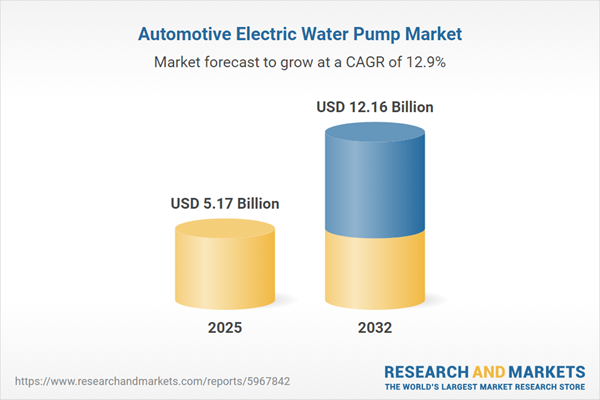Speak directly to the analyst to clarify any post sales queries you may have.
The automotive electric water pump market is experiencing rapid evolution as OEMs and suppliers adapt to advances in powertrain technology, changing regulatory frameworks, and the shift toward vehicle electrification. As strategic priorities evolve, industry leaders are re-evaluating supply chains, integrating digital controls, and expanding their portfolios to maintain resilience and competitiveness.
Market Snapshot: Automotive Electric Water Pump Market
The Automotive Electric Water Pump Market grew from USD 4.59 billion in 2024 to USD 5.17 billion in 2025. It is expected to continue growing at a CAGR of 12.94%, reaching USD 12.16 billion by 2032.
Scope & Segmentation
This report comprehensively analyzes the automotive electric water pump market, focusing on its diverse applications and market drivers across global regions.
- Vehicle Types: Heavy commercial vehicles, light commercial vehicles, passenger cars
- Sales Channels: Aftermarket, OEM
- Engine Types: Diesel engines, electric vehicles, gasoline engines, hybrid electric vehicles
- Motor Technologies: Brushed DC motors, brushless DC motors
- Pump Designs: External pumps, inline pumps
- Regions: Americas (including North America: United States, Canada, Mexico; Latin America: Brazil, Argentina, Chile, Colombia, Peru), Europe, Middle East & Africa (Europe: United Kingdom, Germany, France, Russia, Italy, Spain, Netherlands, Sweden, Poland, Switzerland; Middle East: United Arab Emirates, Saudi Arabia, Qatar, Turkey, Israel; Africa: South Africa, Nigeria, Egypt, Kenya), Asia-Pacific (China, India, Japan, Australia, South Korea, Indonesia, Thailand, Malaysia, Singapore, Taiwan)
- Key Companies: Valeo SA, DENSO Corporation, Continental AG, BorgWarner Inc., MAHLE GmbH, Nidec Corporation, Aisin Seiki Co., Ltd., GMB Corporation, Hitachi Astemo, Ltd.
Key Takeaways: Strategic Insights for Senior Stakeholders
- Electric water pumps are central in meeting modern engine cooling demands and supporting emerging electrified vehicle architectures.
- Smart controls and predictive diagnostics are increasingly standard, enabling real-time system monitoring for proactive maintenance and enhanced reliability.
- Hybrid, battery electric, diesel, and gasoline vehicles each require customized thermal strategies, driving differentiated adoption rates and pump specifications.
- Regional production shifts, including reshoring and localized supply partnerships, are reducing supply chain risk and supporting compliance with shifting trade policies.
- Material advances, such as precision manufacturing and enhanced sealing technologies, are contributing to longer pump life spans and operational efficiency.
- Collaborative ventures between OEMs, component suppliers, and electronics firms are accelerating innovation in functional integration and connectivity features.
Tariff Impact
The introduction of US tariffs on imported automotive electric water pumps in 2025 created significant cost pressures for manufacturers with globalized supply chains. In response, many firms initiated production localization strategies, invested in domestic sourcing, and formed regional collaborations to buffer against tariff exposure. These adjustments have also prompted exploration of new pump materials and architectures, supporting compliance and optimizing total cost of ownership.
Methodology & Data Sources
This research leverages a blend of in-depth consultations with OEM thermal management experts, procurement specialists, and production analysts, supported by quantitative supply chain analysis. Secondary data sources included technical literature reviews, regulatory documents, and patent databases. The methodology ensures robust triangulation and benchmarking to deliver actionable, accurate market intelligence.
Why This Report Matters
- Offers senior executives clarity on the evolving dynamics of electric water pump technology, regulatory drivers, and supply chain strategies for informed capital allocation and risk management.
- Facilitates strategic planning by illuminating key market trends, regional priorities, and opportunities for partnership, efficiency, or product innovation.
- Supports competitive positioning with a comprehensive view of segmentation, emerging technologies, and leading supplier initiatives tailored for the automotive sector.
Conclusion
The trajectory of the automotive electric water pump market will be defined by technology integration, agile supply strategies, and evolving customer and regulatory expectations. Senior stakeholders equipped with these insights can drive resilient operations and capture growth in a dynamic landscape.
Additional Product Information:
- Purchase of this report includes 1 year online access with quarterly updates.
- This report can be updated on request. Please contact our Customer Experience team using the Ask a Question widget on our website.
Table of Contents
3. Executive Summary
4. Market Overview
7. Cumulative Impact of Artificial Intelligence 2025
Companies Mentioned
The companies profiled in this Automotive Electric Water Pump market report include:- Valeo SA
- DENSO Corporation
- Continental AG
- BorgWarner Inc.
- MAHLE GmbH
- Nidec Corporation
- Aisin Seiki Co., Ltd.
- GMB Corporation
- Hitachi Astemo, Ltd.
Table Information
| Report Attribute | Details |
|---|---|
| No. of Pages | 196 |
| Published | October 2025 |
| Forecast Period | 2025 - 2032 |
| Estimated Market Value ( USD | $ 5.17 Billion |
| Forecasted Market Value ( USD | $ 12.16 Billion |
| Compound Annual Growth Rate | 12.9% |
| Regions Covered | Global |
| No. of Companies Mentioned | 10 |









